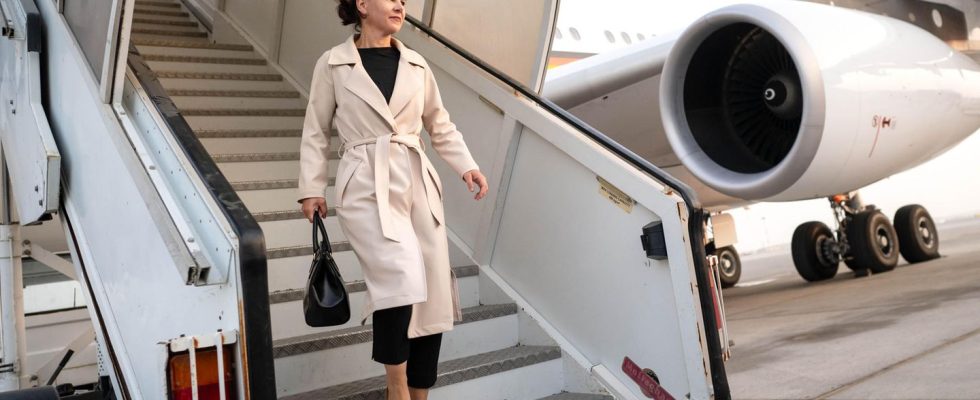landing flaps
Breakdown on the government plane: Baerbock stranded in Abu Dhabi
Only moderately in a good mood: Foreign Minister Annalena Baerbock climbs out of the government plane in Abu Dhabi.
© Sina Schuldt / DPA
Foreign Minister Annalena Baerbock is stranded in Abu Dhabi on her planned trip to Australia. Reason: Once again technical problems on the plane. The then Chancellor Angela Merkel even had to make an emergency landing with it.
At around 4 a.m. local time, the flight captain addressed the “Dear Madam Minister” and the other passengers over the cabin loudspeakers – “with unfortunately not so good news”. The delegation around the Foreign Minister Annalena Baerbock had just made herself comfortable for a long night and day flight to the Australian capital Canberra. The commander explained in a calm tone that there were technical problems with the landing flaps. They didn’t retract fully. No need to worry, you’ve already tried it out on the simulator. The only solution: back to Abu Dhabi, capital of the United Arab Emirates.
A cloud of 80,000 liters of kerosene
The A400 government aircraft took off from there at exactly 3:33 a.m. local time after a stopover. The problem occurred three minutes later, immediately after retracting the landing gear. Since then, the triangular course has been flown almost 3,000 meters above the Gulf in the hope that the problem can be solved in the air. The only thing that was certain was that it would not vanish into thin air. With the landing flaps extended, the aircraft could neither reach the planned flight altitude nor the flight speed, the commander explained. The flight time would be doubled, which would mean that you would practically not reach the intended destination of Australia anyway. Before that, the kerosene would run out.
But right now you had far too much of it on board. The plane had landed in the desert state to refuel. 110 tons, 110,000 liters were in the tanks. It now weighed 271 tons, 80 tons over the maximum allowed landing weight. As a result, 80 tons of kerosene had to be dumped – clearly visible as a white cloud that shot out of the fuel filler necks on both undersides of the wings. It would, it was assured, evaporate before it could reach the ground.
80 minutes circles
With a discharge speed of 1000 liters per minute, Baerbock’s plane had to circle for 80 minutes until the tanks were reasonably empty. The plane was able to land again around half past five local time. An attempt is currently being made to repair it on site. Meanwhile, the minister and delegation have been taken to a hotel.
Baerbock is on his way to a week-long trip to Australia, New Zealand and Fiji. In Australia, among other things, she wanted to give a keynote speech and attend the semi-finals of the Women’s World Cup. After a stopover in the New Zealand capital of Auckland, she wanted to be the first German foreign minister to fly to Fiji to open the German embassy there on the date line.
How safe are the government planes?
The incident is likely to herald a renewed debate about the reliability of German flight readiness. It’s about the conspicuous accumulation of technical problems. The Foreign Minister alone has already been affected three times this year. Once even in the same region. Baerbock left for the Gulf region in mid-May. The trip was ill-fated: the planned government aircraft had already broken down in Berlin at the time, due to hydraulic damage. The replacement aircraft, a gray Airbus troop carrier, then had a puncture in Qatar. A replacement for the special wheel could not be found on board or in the region, but had to be flown in from Germany. Meanwhile, the delegation was stuck in Qatar for a day.
Merkel broke down with the same machine
The machine now affected is reliable despite its age of 24 years, it is said. Since it was not used in regular service, it is considered a new car to a certain extent. Which doesn’t mean she doesn’t cause trouble. On the contrary: It is the same machine with which the then Chancellor Angela Merkel got into serious problems in 2018. On their flight to the G20 summit in Buenos Aires, all communication failed shortly after take-off. The reason was an electronic problem. This also ensured that the prescribed draining of excess aviation fuel did not work and the machine was therefore too heavy for the planned emergency landing in Cologne. Upon landing, several fire brigades had lined the runway for safety. At the time, Merkel had to switch to a scheduled flight. However, she only made it to the summit with a delay.
It is currently unclear how and whether the Foreign Minister’s trip will continue. Even if the error could be corrected, the crew would have to pause for at least twelve hours for labor reasons before they could set off again for Australia. Another option would be to request a replacement machine from Cologne, but that also takes time. There is also another obstacle: The defective machine had already stepped in to replace the originally planned aircraft. This has a defect.


